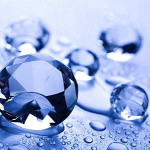Created by: Silentchapel
Number of Blossarys: 95
Aventurine is a form of quartz, characterised by its translucency and the presence of platy mineral inclusions that give a shimmering or glistening effect termed aventurescence. The most common ...
Agate is a microcrystalline variety of silica, chiefly chalcedony, characterised by its fineness of grain and brightness of color. Although agates may be found in various kinds of rock, they are ...
Amethyst is a violet variety of quartz often used in jewelry. The name comes from the Ancient Greek ἀ a- ("not") and μέθυστος methustos ("intoxicated"), a reference to the belief ...
The name chrysoberyl is derived from the Greek words χρυσός chrysos and βήρυλλος beryllos, meaning "a gold-white spar". Despite the similarity of their names, chrysoberyl and beryl are two ...
Diamond is renowned as a material with superlative physical qualities, most of which originate from the strong covalent bonding between its atoms. In particular, diamond has the highest hardness and ...
Emerald is a gemstone, and a variety of the mineral beryl, colored green by trace amounts of chromium and sometimes vanadium. Beryl has a hardness of 7.5–8 on the 10-point Mohs scale of mineral ...
Jasper, a form of chalcedony, is an opaque, impure variety of silica, usually red, yellow, brown or green in color; and rarely blue. The common red color is due to iron(III) inclusions in what is ...


 English (EN)
English (EN) 




